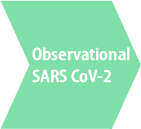A potent selective serotonin (5-HT) reuptake inhibitor (SSRI) belonging to the 2-aminoethyl oxime ethers of aralkylketones series and is unrelated to other SSRIs and clomipramine. It was found to bind to the sigma – 1 receptor in immune cells, following in reduced production of inflammatory cytokines. Fluvoxamine’s proposed mechanism in the setting of COVID is multifactorial: both serotonin uptake by platelets and histamine release from mast cells are reduced. Lysosomotrophic effects limit the virus’ ability to be transported through the cell which reduces its ability to bind to key sites for replication. The final proposed mechanism for fluvoxamine in the setting of COVID surrounds inhibition of IRE-1 mediated inflammation and melatonin degradation.
More data are needed on dosing and mechanisms of effect; however, fluvoxamine appears to have substantial potential as a safe and widely available medication that could be repurposed to ameliorate serious COVID-19-related morbidity and mortality. As of April 2021, fluvoxamine was mentioned in the NIH COVID-19 treatment guidelines, although no recommendation is made for or against use. Results from adequately powered, well-designed, and well-conducted clinical trials are needed to provide more specific, evidence-based guidance on the role of fluvoxamine for the treatment of COVID-19. However, available data may warrant clinician discussion of fluvoxamine as a treatment option for COVID-19, using shared decision making.
Clinical Circumstances
What severity of COVID-19 would you recommend use of this medication (i.e. mild, moderate, or severe illness; outpatient vs inpatient use)?
- The use of fluvoxamine should be limited to outpatient treatment of mild-moderate COVID-19 in an attempt to prevent progression to severe disease.
Would you recommend restricting this medication in some way (for example, “can be considered in consultation with ID”)
- No restriction.
Med-specific considerations
Based on the current literature, what dosing is recommended?
- Based on dosing used in existing trials, we recommend a dose of 50-100mg twice daily for 10 days. Maximum dosing 300mg/day.
- Dosing used in TOGETHER: 100mg PO BID for 10 days.
- Dosing used in STOP COVID: 50mg for one day, then 100mg BID for two days, then 100mg TID (as tolerated) through day 15.
Is drug monitoring required? If so, what is suggested?
- Evaluate mental status, suicidal ideation (especially at the beginning of therapy or when doses are increased or decreased), anxiety, social functioning, mania, panic attacks or other unusual changes in behavior
- Monitor for signs/symptoms of serotonin syndrome; akathisia; weight and BMI;
- Measure hepatic function (baseline and as clinically indicated).
Supply and procurement consideration: Is treatment currently available for use in our system, and if so are short ages anticipated? Are there currently restrictions or other barriers?
No current supply concerns.
Use in special populations. Please consider use in special populations (pregnancy, immunosuppressed, kidney or liver disease, etc.) and outline any concerns below.
- Pregnancy:
- Insufficient data to determine fetal risk when used in pregnant women. Only use in pregnant women if potential maternal benefit outweighs potential fetal risk.
- Breast feeding: Insufficient data exists to rule out infant risk. Benefits should be weighed against potential risks before starting therapy while breastfeeding.
- Hepatic insufficiency: a reduction in initial dose and slower dose titration may be required.
 = Supporting use article = Supporting use article |
 = Neutral Article = Neutral Article |
 = Contradicting use article = Contradicting use article |

 |
 |
 |
   |
   |
 |
Peer-reviewed Publications
 Randomized Control Trial SARS CoV-2
Randomized Control Trial SARS CoV-2
 STOP COVID-1: Lenze EJ, Mattar C, Zorumski CF, et al. Fluvoxamine vs Placebo and Clinical Deterioration in Outpatients With Symptomatic COVID-19: A Randomized Clinical Trial. JAMA. 2020;324(22):2292–2300. doi:10.1001/jama.2020.22760
STOP COVID-1: Lenze EJ, Mattar C, Zorumski CF, et al. Fluvoxamine vs Placebo and Clinical Deterioration in Outpatients With Symptomatic COVID-19: A Randomized Clinical Trial. JAMA. 2020;324(22):2292–2300. doi:10.1001/jama.2020.22760
- A fully remote, double-blind, placebo-controlled randomized trial,
- N=152 (80 of then assigned to fluvoxamine, and 72 assigned to placebo).
- Inclusion criteria: Adults, living in the community, non-hospitalized adults with confirmed severe acute respiratory syndrome coronavirus 2 infection, with COVID-19 symptoms onset with in 7 days and oxygen saturation of 92% or greater.
- Compared treatment:
- Participants were randomized 1:1 fluvoxamine or matching placebo capsule
- Participants received 50mg fluvoxamine (or matching placebo), then 2 days a dose of 100 mg twice daily as tolerated, then increase to a dose of 100 mg 3 times daily as tolerated until day 15, then stopped.
- Exclusion criteria: included having COVID-19 that required hospitalization or evidence of the primary end point with oxygen saturation < 92% ,actively suicidal or psychosis, Prednisone dose greater than 20 mg/d, Severe underlying lung disease (eg, chronic obstructive pulmonary disease or required home oxygen, interstitial lung disease, pulmonary hypertension, decompensated cirrhosis, congestive heart failure, and immunocompromised patients.
- Primary Endpoint:
- Clinical deterioration occurred in 0 of 80 patients in the fluvoxamine group in 6 of 72(8.3%) participants in the placebo group. absolute difference 8.7%; 95% CI, 1.8% to 16.5%; P = 0.009).
- Statically significant
- Clinical deterioration occurred in 0 of 80 patients in the fluvoxamine group in 6 of 72(8.3%) participants in the placebo group. absolute difference 8.7%; 95% CI, 1.8% to 16.5%; P = 0.009).
- Secondary Endpoint:
- Five participants in the placebo arm and one in the fluvoxamine arm required hospitalization.
- In the placebo group, cases of clinical deterioration ranged from 1 to 7 days after randomization and from 3 to 12 days after the onset of COVID-19 symptoms
- No study participants were rated 2 (shortness of breath and oxygen saturation <92% plus supplemental oxygen needed), 4 (oxygen saturation <92% plus supplemental oxygen needed, and hospitalization related to dyspnea or hypoxia plus ventilator support needed for <3 days), or 6 (death).
- Adverse Events
- The fluvoxamine group had 1 serious adverse event and 11 other adverse events, whereas the placebo group had 6 serious adverse events and 12 other adverse events. Pneumonia and gastrointestinal symptoms (such as nausea and vomiting) occurred more often in the placebo group compared with those who received fluvoxamine.
- Conclusion
- The potential advantages of fluvoxamine for outpatient treatment of COVID-19 include its safety, widespread availability, low cost, and oral administration. Fluvoxamine does not promote QT prolongation unlike other SSRIs. However, fluvoxamine has adverse effects and can cause drug-drug interactions, particularly via inhibition of cytochromes P450 1A2 and 2C19.
- In this preliminary study of adult outpatients with symptomatic COVID-19, patients treated with fluvoxamine, compared with placebo, had a lower likelihood of clinical deterioration over 15 days. However, the study is limited by a small sample size and short follow-up duration, and determination of clinical efficacy would require larger randomized trials with more definitive outcome measures.
 TOGETHER: Reis G, Dos Santos Moreira-Silva EA, Silva DCM, et al. Effect of early treatment with fluvoxamine on risk of emergency care and hospitalisation among patients with COVID-19: the TOGETHER randomised, platform clinical trial [published online ahead of print, 2021 Oct 27]. Lancet Glob Health. 2021;S2214-109X(21)00448-4. doi:10.1016/S2214-109X(21)00448-4
TOGETHER: Reis G, Dos Santos Moreira-Silva EA, Silva DCM, et al. Effect of early treatment with fluvoxamine on risk of emergency care and hospitalisation among patients with COVID-19: the TOGETHER randomised, platform clinical trial [published online ahead of print, 2021 Oct 27]. Lancet Glob Health. 2021;S2214-109X(21)00448-4. doi:10.1016/S2214-109X(21)00448-4
- Multisite, Placebo-controlled, randomized, adaptive platform trial
- N = 1497 symptomatic adults confirmed with SARS-CoV-2 at high-risk for progression to severe disease (outpatient/community setting)
- Composite endpoint: Hospitalization defined as either retention in a COVID-19 emergency setting or transfer to tertiary hospital due to COVID-19 up to 28 days post-random assignment on the basis of intention to treat.
- Average age of study participants was 50 years old and 58% were female
- 1:1 randomization – Intervention: Fluvoxamine 100mg twice daily for ten days; Control: Placebo twice daily for ten days
- Inclusion criteria: adults (over the age of 18) outpatients with a symptomatic presentation, 7 days or less, consistent with COVID-19 or a positive rapid antigen test done at the time of screening. These patients had to also have a high risk factor (DM, HTN, CVD, underlying lung disease, CKD IV, transplant, or immunosuppressed.
- Composite endpoint: Hospitalization defined as either retention in a COVID-19 emergency setting or transfer to tertiary hospital due to COVID-19 up to 28 days post-random assignment on the basis of intention to treat.
- Results:
- Primary outcome: 79 patients of the fluvoxamine group (11%) compared to 119 patients in the control group (16%) experienced the primary outcome.
- 5% absolute risk reduction (32% RRR) on primary outcome (hospitalization); NNT with the ITT analysis was 20 patients (i.e. treating 20 patients with fluvoxamine compared to placebo would prevent 1 additional hospitalization)
- No significant differences between intervention and control arm with respect to adverse drug events
- Conclusion
- This study showed that a 10 day course of fluvoxamine 100mg twice daily compared to placebo had a positive effect of reducing the number of patients who reached the primary outcome.
 Observational SARS CoV-2
Observational SARS CoV-2
 Seftel, David, and David R. Boulware. “Prospective Cohort of Fluvoxamine for Early Treatment of Coronavirus Disease 19.” Open Forum Infectious Diseases, vol. 8, no. 2, Feb. 2021, p. ofab050. DOI.org (Crossref), https://doi.org/10.1093/ofid/ofab050.
Seftel, David, and David R. Boulware. “Prospective Cohort of Fluvoxamine for Early Treatment of Coronavirus Disease 19.” Open Forum Infectious Diseases, vol. 8, no. 2, Feb. 2021, p. ofab050. DOI.org (Crossref), https://doi.org/10.1093/ofid/ofab050.
- A prospective, nonrandomized observational cohort study
- N=113 outpatients who tested positive from SARS-CoV-2 antigen (65 opted to take fluvoxamine, and 48 declined). The median age was 42 years (interquartile range, 33 to 56
- Fluvoxamine was prescribed with a 50- to 100-mg loading dose, then 50 mg twice daily for 14 days. The facility provided the fluvoxamine at no cost. All patients were followed up in-person at 7 and 14 days.
- Inclusion criteria: Adults with SARS-COV-2 antigen positive persons, approximately half were asymptomatic when initially tested. The median age was 42 years
- Results:
- At Day 14, none of the patients who received fluvoxamine versus 60%(29 of 65) of those who did not had persistent symptoms (anxiety, difficulty concentrating, fatigue, insomnia, headache, myalgia) (P < 0.001).
- By Day 14, none of the fluvoxamine-treated patients were hospitalized; six patients who did not receive fluvoxamine were hospitalized, including two patients who required care in the intensive care unit.
- No serious adverse events were reported following receipt of fluvoxamine.
- Conclusion
- Overall, fluvoxamine seems to be promising as early treatment for COVID-19 to prevent clinical deterioration requiring hospitalization and to prevent possible long-haul symptoms persisting beyond 2 weeks. Further randomized trial evidence is needed. On December 17, 2020, a new nationwide, internet-based phase III randomized trial began to confirm these initial results.
 Calucic et al. Safety and efficacy of fluvoxamine in COVID‐19 ICU patients: An open label, prospective cohort trial with matched controls. Br J Clin Pharmacol. 2021 Dec 1 : 10.1111/bcp.15126.
Calucic et al. Safety and efficacy of fluvoxamine in COVID‐19 ICU patients: An open label, prospective cohort trial with matched controls. Br J Clin Pharmacol. 2021 Dec 1 : 10.1111/bcp.15126.
- Methods
- The study was designed as an open‐label, prospective cohort trial with matched controls.
- 51 ICU COVID‐19 patients were treated with fluvoxamine 100 mg three times daily for 15 days in addition to standard therapy and they were prospectively matched for age, gender, vaccination against COVID‐19, disease severity and comorbidities with 51 ICU controls.
- Results
- No statistically significant differences between groups were observed regarding the number of days on ventilator support, duration of ICU or total hospital stay.
- However, overall mortality was lower in the fluvoxamine group, 58.8% (n = 30/51), than in the control group, 76.5% (n = 39/51), HR 0.58, 95% CI (0.36–0.94, P = .027).
- Conclusion
- Fluvoxamine treatment in addition to the standard therapy in hospitalised ICU COVID‐19 patients could have a positive impact on patient survival.
- Methods
Major peer-reviewed studies providing context for therapy
- Sukhatme VP, Reiersen AM, Vayttaden SJ, Sukhatme VV. Fluvoxamine: A Review of Its Mechanism of Action and Its Role in COVID-19. Front. Pharmacol., 20 April 2021 | https://doi.org/10.3389/fphar.2021.652688
- Oskotsky et al. Mortality Risk Among Patients With COVID-19 Prescribed Selective Serotonin Reuptake Inhibitor Antidepressants. JAMA Netw Open. 2021 Nov 1;4(11):e2133090. doi: 10.1001/jamanetworkopen.2021.33090.
Current Clinical Trials
Four larger randomized clinical trials are currently underway, including three in the USA and Canada.
ClinicalTrials.gov list of trials for fluvoxamine in COVID-19